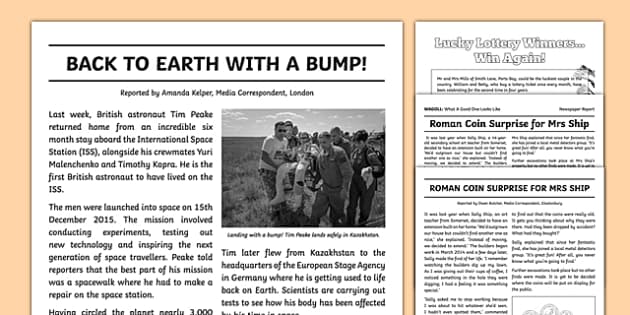News Articles Can Be Fun For Anyone
All about News Articles
Table of ContentsHow News Articles can Save You Time, Stress, and Money.The Greatest Guide To News Articles8 Simple Techniques For News ArticlesThe Ultimate Guide To News ArticlesWhat Does News Articles Do?
Good knowledge of different subjects provides trainees an affordable side over their peers. Although digital and social media are conveniently accessible, we ought to not neglect just how essential it is to review the papers. Parents need to attempt and instill the habit of reviewing a paper as a day-to-day regimen to continue the legacy of the revered print medium.Information stories also include at least one of the complying with vital qualities relative to the designated audience: distance, prominence, timeliness, human rate of interest, strangeness, or repercussion.
Within these limits, news tales additionally intend to be thorough. Among the bigger and more reputable newspapers, justness and balance is a significant element in providing info.
Papers with an international audience, as an example, often tend to utilize a more official design of creating. The specific options made by an information outlet's editor or content board are commonly accumulated in a style guide; common style overviews include the and the United States Information Style Publication. The main objectives of information writing can be summed up by the ABCs of journalism: accuracy, brevity, and clearness.
Getting My News Articles To Work
As a rule, reporters will not utilize a long word when a short one will do. Information writers attempt to prevent making use of the very same word extra than when in a paragraph (often called an "resemble" or "word mirror").
However, headlines often omit the topic (e.g., "Jumps From Boat, Catches in Wheel") or verb (e.g., "Cat lady fortunate"). A subhead (likewise subhed, sub-headline, subheading, caption, deck or dek) can be either a subservient title under the major headline, or the heading of a subsection of the short article. It is a heading that comes before the main text, or a group of paragraphs of the major message.

of a post subject, informant, or interviewee), it is described as a pulled quote or draw quote. Extra billboards of any of these types might show up later in the article (particularly on subsequent web pages) to lure further reading. Journalistic sites occasionally utilize animation strategies to swap one billboard for another (e.g.
Rumored Buzz on News Articles
Such billboards are also made use of as pointers to the short article in various other areas of the magazine or site, or as promotions for the item in various other publication or websites. News release of the Swiss federal government. Regular structure with title, lead paragraph (summary in vibrant), other paragraphs (details) and call information.

Instance of a hard-lead paragraph NASA is proposing another area project. The agency's budget request, introduced today, consisted of a plan to send one more objective to the Moon. This moment the company wants to establish a lasting facility as a jumping-off factor for other space adventures. The spending plan requests roughly $10 billion for the task.
An "off-lead" is the 2nd most see post vital front page information of the day. To "hide the lead" is to begin the short article with background information or information of secondary importance to the visitors, forcing them to check out more deeply right into a short article than they must have to in order to find the necessary factors.
The Only Guide to News Articles
Usual use is that one or two sentences each create their own paragraph. Reporters usually define the company or structure click site of a newspaper article as an inverted pyramid. The necessary and most interesting elements of a story are put at the beginning, with sustaining details following in order of reducing importance.
It enables individuals to check out a topic to only the deepness that their inquisitiveness takes them, and without the imposition of details or nuances that they might consider unimportant, however still making that information readily available to much more interested readers. The upside down pyramid structure also makes it possible for short articles to be cut to any approximate size during layout, to fit in the area available.
Some authors begin their stories with the "1-2-3 lead", yet there are lots of sort of lead offered. This layout invariably begins with a "Five Ws" opening paragraph (as defined above), adhered to by an indirect quote that offers to support a significant component of the first paragraph, and afterwards a direct quote to sustain the indirect quote. [] A kicker can describe multiple points: The last story current broadcast; a "delighted" story to finish like this the show.
Longer short articles, such as publication cover articles and the pieces that lead the inside areas of a newspaper, are understood as. Feature stories differ from straight information in numerous ways.
News Articles Can Be Fun For Anyone
The journalist often information communications with meeting subjects, making the piece a lot more individual. An attribute's first paragraphs usually connect an interesting moment or occasion, as in an "unscientific lead". From the details of a person or episode, its sight quickly broadens to generalizations about the tale's subject. The section that signifies what a feature has to do with is called the or signboard.

The Editor's Tool kit: A Reference Guide for Beginners and Professionals (2001) Allan M. Siegal and William G. Connolly. The New York Times Handbook of Design and Usage: The Official Style Guide Used by the Writers and Editors of the World's Many Authoritative Paper (2002) M. L. Stein, Susan Paterno, and R.